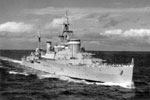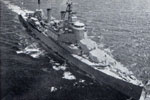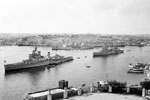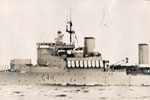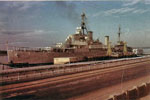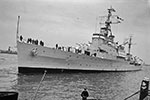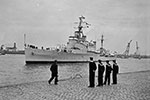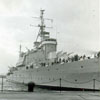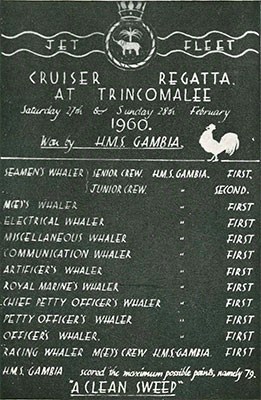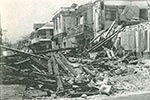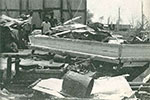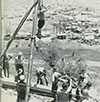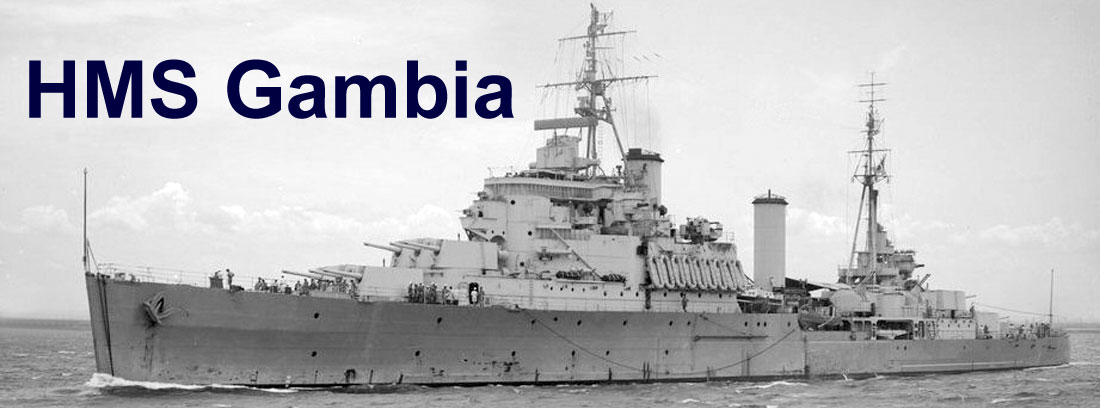
The 1958 to 1960 Commission
On 4 November 1958 she recommissioned for the 1st Cruiser Squadron in the Mediterranean. She deployed to the Far East on 4 December 1959 to relieve the cruiser Ceylon in the Red Sea. HMS Gambia returned to the UK via South Africa with a visit to Freetown and the Gambia, before arriving in Portsmouth in July 1960.
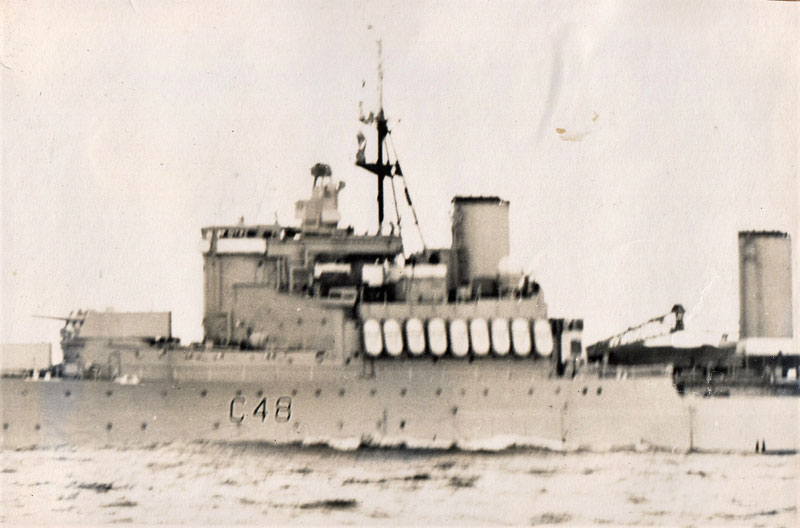
An unusual photo of HMS Gambia. What makes this unusual is that I received it in September 2018 from Sergey who has a Russian email address and he said the photo was taken from one of the Soviet intelligence gathering AGI (Auxiliary, General Intelligence) trawlers. The trawlers were deployed to the Western Atlantic from the Kola region naval base of Murmansk and Sergey thinks the ships met each other around May/June 1960, close to UK waters.
For the last months of 1960 she served in the South Atlantic and the Home Fleet before entering the reserve in December of that year, her crew largely going to the new cruiser Blake. Gambia was paid off to reserve in December 1960 and she remained at Portsmouth until she was put on the disposal list and sold to Thomas W. Ward for scrapping.
Exercise Dawn Breeze IV
HMS Gambia took part in Exercise Dawn Breeze IV in the eastern Atlantic between March 17 and 24, 1959. A NATO press release of March 10, 1959 describes the exercise as " to give training to the naval and marine air units of the participating nations in the conduct of anti-submarine warfare and in the air defence of a task group at sea."
It goes on to say that "The seagoing forces will comprise 3 aircraft carriers, 1 cruiser, 1 fast minelayer, 1 depot ship, 2 auxiliaries and 18 destroyers and frigates (UK), 1 headquarters ship, 1 auxiliary and 3 destroyers and frigates (French); 3 escorts (Danish); 2 escorts (Portuguese). These forces will be supported by Shackleton long-range maritime aircraft of Coastal Command, RAF, and Harpoons of the Portuguese Air Force. Opposing the sea-going forces will be Vulcans, Victors, Valiants and Canberras of UK Bomber Command, aircraft of the 3rd US Air Force, Neptune of the French Navy and 8 UK and 2 French submarines."
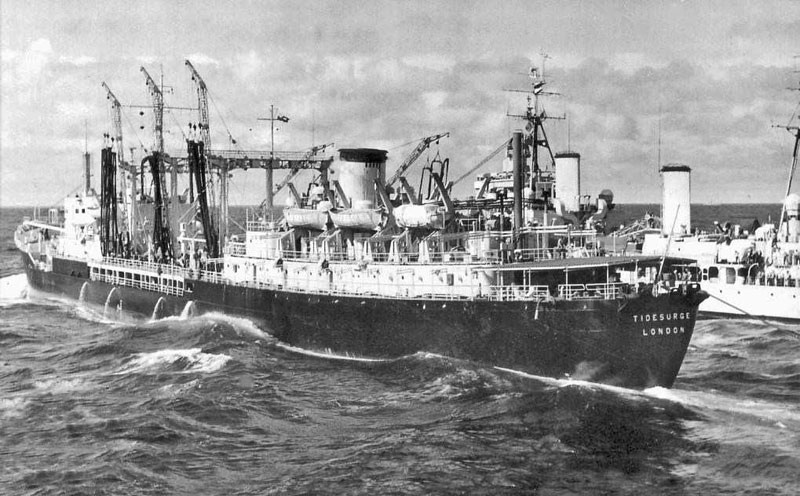
RFA Tidesurge with HMS Gambia (behind), Exercise Dawn Breeze IV, March 1959
A copy of the NATO press release, RDC/59/72, can be found here or from the NATO Archives.
Exercise Fairwind IV
HMS Gambia took part in Exercise Fairwind IV, a NATO Naval Air Exercise, held in the eastern Atlantic and Scandinavian waters between May 25 and June 12, 1959. It was one of the regularly conducted Allied Command Atlantic Exercises held in conjunction with the annual movements of the United Kingdom Home Fleet.
The first phase of the exercise was a weapon training period in United Kingdom home waters from May 25 to June 6. The second phase was an air defence and anti-submarine warfare tactical exercise while the forces taking part were enroute to the Skagerrak between June 8 and 12. Approximately 40 ships and 50 aircraft participated in the exercise.
A copy of the NATO press release, PO/59/639, can be found here or from the NATO Archives.
On July 26, 1929, HMS Devonshire suffered a devasting accident. While engaged in firing practice in the Aegean, off the island of Skhiatos, at exactly 10.00 Devonshire fired her first broadside, but almost simultaneously a huge explosion shook the ship. The left gun of "X" turret had misfired. The breech operator not realizing it, opened the breech block causing the charge inside the barrel to explode and also ignite the next one inside the turret. The force of the explosion blew the roof off the gun turret and started fires in the gun house and pump room. The fires were soon extinguished but an officer and six men were killed instantly, one of them being blown overboard. Devonshire made for the Greek port of Volos where 17 injured men were transferred to the hospital ship Maine. However, 11 of these subsequently died and 16 of the victims were buried at Volos with full military honours. Devonshire returned to England for repairs in August with "the turret swung 'round and the guns awry".
Royal Fleet Auxiliary (RFA) Brown Ranger carried the the Band of the Royal Highland Regiment from Cyprus, and on November 23, 1959 met up with HMS Gambia off Malta and transferred the band to her for a memorial service on the island of Volos at the grave sides of those killed in the turret explosion on HMS Devonshire 30 years earlier.

The rememberance service at Volos
The event appeared in the January 1960 edition of Navy News:
H.M.S. Devonshire Victims Remembered
Gambia Visitis Volos
Simple Memorial Service
On July 26, 1929, an explosion in an 8 in. gun turret of Devonshire killed the gunhouse crew of 17 Royal Marines and one Naval rating while the ship was exercising in the Western Aegean. The cruiser put into Volos Bay and her dead were buried in the little cemetery above the town of Volos in a section set aside for them. During the last 30 years the towns people of Volos have cared for these graves, even throughout bitter Cyprus period, and now the Royal Navy has acknowledged their kindliness by sending H.M.S. Gambia to Volos as an expression of gratitude and to renew our friendly relations with the people.
For the occasion Gambia called at Piraeus (Athens) to embark the British Ambassador to Greece. Sir Roger Allen, K.C.M.G. and the following morning, Saturday, November 28, berthed alongside in Volos harbour. Also on hoard were the Pipes and Drums of the 1st Battalion The Black Watch of the Royal Highland Regiment who had a lively experience being transferred by jackstay at sea from the tanker Brown Ranger.
During the reception held onboard Gambia that evening her Commanding Officer (Capt. W. J. Munn, D.S.O., O.B.E., R.N.) presented a silver cup to the Mayor of Volos as a permanent memento of the tie between the town and the Royal Navy. This cup, which had belonged to Devonshire, was inscribed "This relic or H.M.S. Devonshire was presented to the Mayor and Municipality of Volos on the occasion of the visit of H.M.S. Gambia. November 29, 1959."
On Sunday morning a Guard of Honour of Royal Marines and an unarmed party of three platoons of sailors marched the two miles from the ship to the cemetery headed by the Pipe Band. A simple memorial service was conducted in the cemetery by the Chaplain of H.M.S. Gambia (Rev. J. T. Cummin) assisted by the Bishop of Volos who took part of the service and the Volos Municipal Band ably played the hymns and National Anthems. The service was attended by Their Excellencies the British Ambassador and Lady Allen, the Naval and Military Attaches, the Nomarch, the Mayors of Voles and New Ionoa and some 3.000 local inhabitants. From the silent and moving behaviour of the crowd, many Of the older women being in tears, it was obvious that they were not there through vulgar curiosity.
That afternoon, when the ship was open to visitors. some 8,000 local persons flocked to look over the cruiser. It was only a display by the Pipers on the esplanade nearby that drew off the crowds still waiting to onboard after sunset.
1958/60 Regattas
It seems whenever more than two ships berthed together a regatta was organized and it was a point of pride to win. This is taken from the 1958/60 Commission Book
Our crews, together with helpers, organisers and maintainers, numbered nearly one hundred and fifty during our first regatta at Augusta; and at Trincomalee about eighty were involved. To keep this number keen, enthusiastic and fit is a huge task, and sincere thanks are due to all those who made such determined efforts to get the best results.
We had two regattas and two challenge races during the Commission: the regattas in Sicily and Ceylon, and the challenge races at Malta and Gibraltar.
For the regatta at Augusta our training started during our foreign service leave at Rosyth. Our efforts at training were hampered by leave and sea-time, although every effort was made to get the crews away whenever the opportunity presented Itself. Everyone found the change of climate from the rigours of an English summer to the heat in Grand Harbour trying in the extreme, and the heat seemed to produce a feeling of lassitude or exhaustion and tempers became short.
The regatta embraced the Mediterranean sea-going fleet, and though shore establishments were entered, naturally they did not score points towards the cock.
The larger ships had to provide two crews for each event, total points for the event being obtained by adding the points gained by the two crews and then halving the answer. This meant that if we were to stand a chance both our crews would have to come in the first four in each race. The cards were in fact stacked heavily against us, the destroyers and frigates having to provide only one entry were on a very much easier wicket.
The final placings put ULYSSES on top with 126 points, DEFENDER next with 107, and GAMBIA third with 95. A total of fifteen ships were engaged and we did well indeed to beat BIRMINGHAM, being first among the ships plagued by the necessity of providing two boats.
The second regatta took place at Trincomalee on Saturday, 27th February, 1960. This was really a cruiser regatta and was in competition those cruisers taking part in Exercise JET 60.
Training began at Karachi in mid-January and we were able to take a good run at it, having four weeks in which to concentrate without interruption. Naturally we continued our training at sea whenever possible. In every respect we were a much more settled crowd. We had plenty of reserves to fall back on as only one crew was required for each category.
The ships against us were the Indian Naval Ships DELHI and MYSORE and H.M.S. BELFAST. We were concerned about our chances against BELFAST as she had recently collected the Far East Cock at Hong Kong. Further concern was felt when we heard that she had left two of her crews behind while we were at sea on exercise. Fortunately one gathers they spent most of their training time in the bar.
Observers onboard considered that we would give a good account of ourselves, but even our most optimistic soothsayer was staggered in the event. All our crews pulled excellently and the results of continuous and patient training were evident. The strokes were long and pulled through, the crews had stamina, and the coxswains steered straight courses without getting flustered. Two seamen crews were allowed in the first race and we gained first and second places, the senior crew just pipping the youngsters on the ppst by a matter of feet.
Each race thereafter was made up of two categories, thus the M(E)s and Electrical crews pulled in the same race. There was no occasion when we did not have the first boat home in each category. Our M(E)s' crew won the second race comfortably in the fastest time of the day, BELFAST's (M(E)s were second, and our Electrical crew were third. Then the Communications and Supply and Secretariat crews were first and second respectively, Artificers and Royal Marines first and third, Petty Officers and Chief Petty Officers first and second, and finally the Wardroom pulled off their race too. At this stage it was impossible to get any ship to take a bet and the successful punter was lucky to see his money returned if he had backed the winner on the tote.
The final points were: GAMBIA 79, BELFAST 53.5, DELHI 35.5, and MYSORE 28. We had not dropped a single point.
Next day a racing whaler event was held, open to all ships present. Nineteen took part and our M(E)s' crew pulled an excellent race to win by about three lengths from CAVENDISH, with BELFAST third. A very satisfactory ending to .a wonderful regatta. Our celebrations were cut short, however, by the ship hemg ordered to Mauritius that night to give assistance in making good the damage caused by their second cyclone.
On two other occasions only did we race against other ships. The Barham Cup which was competed for just before the Fleet sailed for Augusta was a race for whalers manned by E.R.A.s. Ours was not successful, but made a determined effort and came in about a third of the way down the field.
At Gibraltar on our return from the foreign leg we were invited to enter a seaman crew against ARK ROYAL, DUNKIRK, CARRON and JUTLAND.
Here our superiority was most marked although stamina was lacking. A comfortable lead of about five lengths was established, but the crew looked rather the worse for wear at the finish.
Mauritius Disaster Recovery
Cyclone Alix struck Mauritius in January 1960. It killed eight people, injured over a hundred and destroyed over 20,000 buildings and huts. The next month, Cyclone Carol struck Mauritius on the February 27 and 28, 1960 and was at the time, the most severe ever recorded in the island's history. There were over 1,700 casualties; 42 people were killed and 95 seriously injured. Over 100,000 buildings and huts were destroyed or seriously damaged. Nearly 70,000 of the island's total population of 600,000 had to resort to refugee centres. It was estimated that as much as 60 per cent. of the year's sugar crop were lost, as well as 30 per cent. of this season's tea crop.
HMS Gambia had just completed winnig the Far East Cock at the Cruiser Regatta at Trincomalle, Ceylon on Saturady and Sunday, February 27/28 February, 1960 when she was ordered to Mautitius to offer whatever aid it could to the stricken island. By 0415 Gambia was sailing at 25 knots the 2,559 miles to Port Louis, the capital of Mauritius. By 08:00 on March 4, over a 100 of the crew were ashore at work. The crew took it all in their stride as the excerpt from the 1958/60 Commission Book proves:
Thrusting upwards from the abyss of the Indian Ocean a few degrees north of Capricorn and occupying a space the size of a small English county lies the island of Mauritius. A volcanic mass, many millions of years before its discovery by the Portuguese, it was born in some violent convulsion of the sea-bed resulting in the island's arrival above the surface when tremendous upheavals and outpourings of lava must have taken place, for many aged crags and dead craters now covered with vegetation remain to-day while old lava flows sweep seaward from the high central plateau or squeeze themselves through gaps between mountains as bizarre as those of the moon.
Created in violence, the island has never quite succeeded in being thereafter no stranger to nature's turbulence. Lying in that region of the South Indian Ocean where the passage of tropical cyclones is most frequent, M~uritius has experience of heavy devastation, and indeed we found ourselves ordered to the relief and aid of the islanders on just such an occasion after the excesses of Cyclone Carol.
There was consequent and intense damage to crops and to buildings, a dislocation of essential services and a consequent loss of life. Mauritius has been described as being 'like a place permanently recovering from a bad air raid the year before last.' and normally it is in a poor enough state of disrepair, and now again victim of intense hurricane force winds we were prepared for devastation and havoc.
Our working parties did in fact set about restoring communications and encouraging the clearing away of storm damage as well as bringing more essential supplies to the island. Specialised knowledge was made use of in setting reservoir supplies to rights, establishing a radio telephone link with opposite ends of the island, while the medical profession worked to the limit administerin inoculations against the event of serious epidemic. A good heart and abundant cheerfulness achieved as much in encouraging the local inhabitants, as did the hard work itself demanded of us. Though necessitated by the misfortune of others, the visit proved one not only of great interest but one of some achievement in itself uniquely memorable.
But even the more normal appearance. of the island to-day with waving plains of sugar cane, groves of coconut trees and orderly ranks of casuarinas, is vastly different from the general aspect which presented itself to the first Dutch settlers. In earlier days there was a mantle of forest from the topmost peaks to sea level this strange indigenous vegetation still lingers on some mountain-tops and there is still the odd patch of original thick-limbed and tall tough trees of which ebony is the commonest; the gloom of erect grey trunks is enmeshed in the twisted lianas, 'dropping from the upper branches like strands of immobilised treacle,' while the picture is set off by the solitary note of some bird or the sight of the lone heron pensive by some dark pool. Mauritius presents two faces and can be a colourless unblossoming world dripping softly with abundant rain, though it had more often been described as an island of "sweetness and light."
HMS Gambia was at Mauritius from March 4 to March 10, 1960. The men from HMS Gambia repaired and erected telegraph poles and repaired cables, made emergency repairs to houses with material taken from disused buildings, repaired the power station and restarted it, and carried out repairs to the Blare Longue Reservoir. Medical staff set up a center in a waiting room of Port Louis' railway station and innoculated people against diseases such as typhoid.
Tick-Tock Winds Down
This article appeared in the May 1997 issue of Navy News:
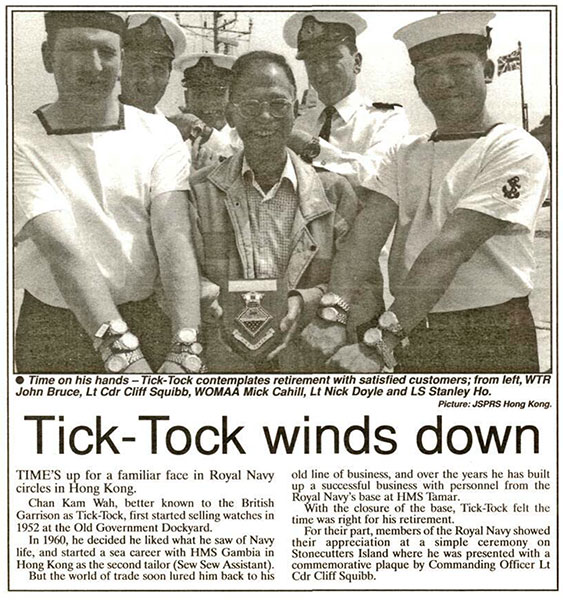
Tick-Tock Winds Down
TIME'S up for a familiar face in Royal Navy circles in Hong Kong.
Chan Kam Wah, better known to the British Garrison as Tick-Tock, first started selling watches in 1952 at the Old Government Dockyard.
In 1960, he decided he liked what he saw of Navy life, and started a sea career with HMS Gambia in Hong Kong as the second tailor (Sew Sew Assistant).
But the world of trade soon lured him back to his old line of business, and over the years he has built up a successful business with personnel from the Royal Navy's base at HMS Tamar.
With the closure of 'the base, Tick-Tock felt the time was right for his retirement.
For their part, members of the Royal Navy showed their appreciation at a simple ceremony on Stonecutters Island where he was presented with a commemorative plaque by Commanding Officer Lt Cdr Cliff Squibb.
A little more insight into the services that could be provided in port can be seen in the extract from HMS Victorious' Commission Book of 1966/67:
K.P.'s Boys
Few of us appreciate the great service done by "K.P." and his teams of laundrymen, tailors and cobblers. We tend to take for granted the efficient laundry service, and the facilities provided onboard for tailoring and shoe-making and forget the hard work, often under unpleasant conditions, and very long separations from their families in Hong Kong, which is the lot of our "firms". If it were not for them we would have to provide our own laundry team from the Ship's Company and would have no tailoring or shoe repair facilities onboard.
H.M. Ships on the Far East Station are allowed to employ these firms. They are controlled by the Commodore-in-Charge Hong Kong and their insurance, contracts, price lists and personal record are all carefully scrutinised. How do these firms start? Take the story of K. P. Lau or Lau Kan Pui to quote his proper name. He started as an apprentice tailor in H.M.S. Unicorn in 1949 and in 1953 spent a year ashore in Hong Kong doing business with ships in the dockyard. From there he joined H.M.S. Chichester as No. 1 Boy in charge of the Tailor's Shop and about a year later transferred to H.M.S. Belfast. He first became his own boss with a small tailoring firm in H.M.S. Gambia and finally transferred to H.M.S. Victorious in 1960. He now employs 44 men in the three firms in Victorious as well as running the firms in H.M.S. Forth and a business in Kowloon.
Further Reading
HMS Gambia 1958/60 Commission Book
Navy News - January 1960 - Royal Navy | Internet Archive | This site
The Beatles
I had an intriguing email in August 2024, from Ted Widmer who is doig some research on The Beatles. HMS Gambia was in Hamburg, Germany from Novermber 14 to 19, 1960. The Beatles were playing in the city from August 1960 to May 1962 so it is possible that at least some of HMS Gambia's crew saw some of the earliest gigs by the group.
I know it was a long time ago, but if anyone remembers seeing The Beatles in Hamburg, or has relatives that did, whether they were crew members or not, we would love to hear from you - brisray@yahoo.co.uk.
